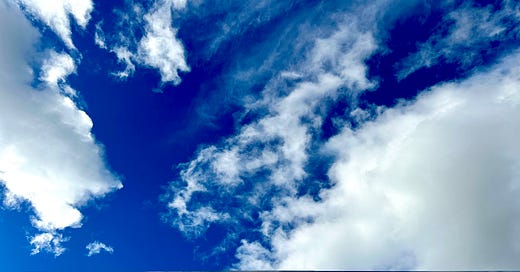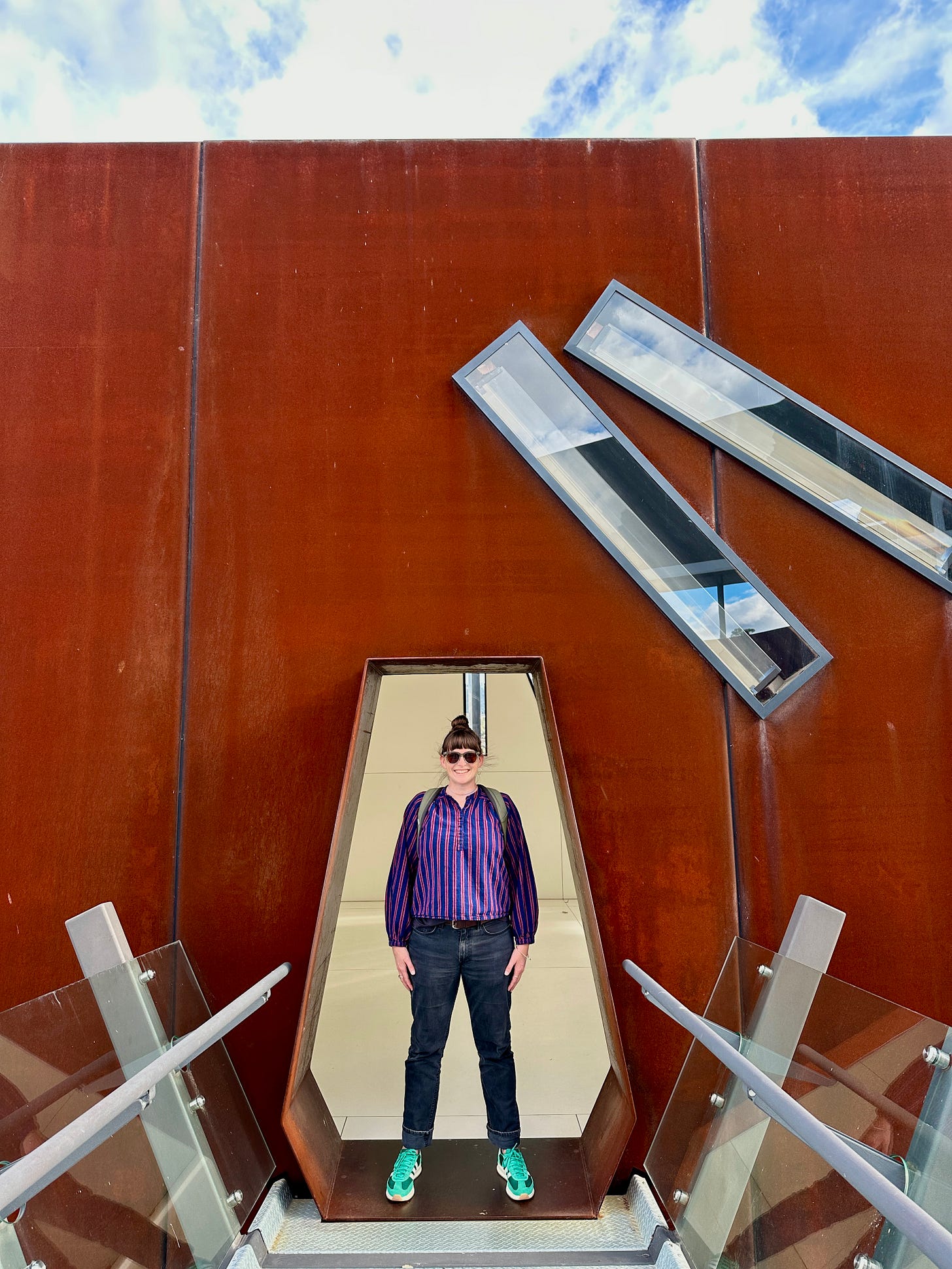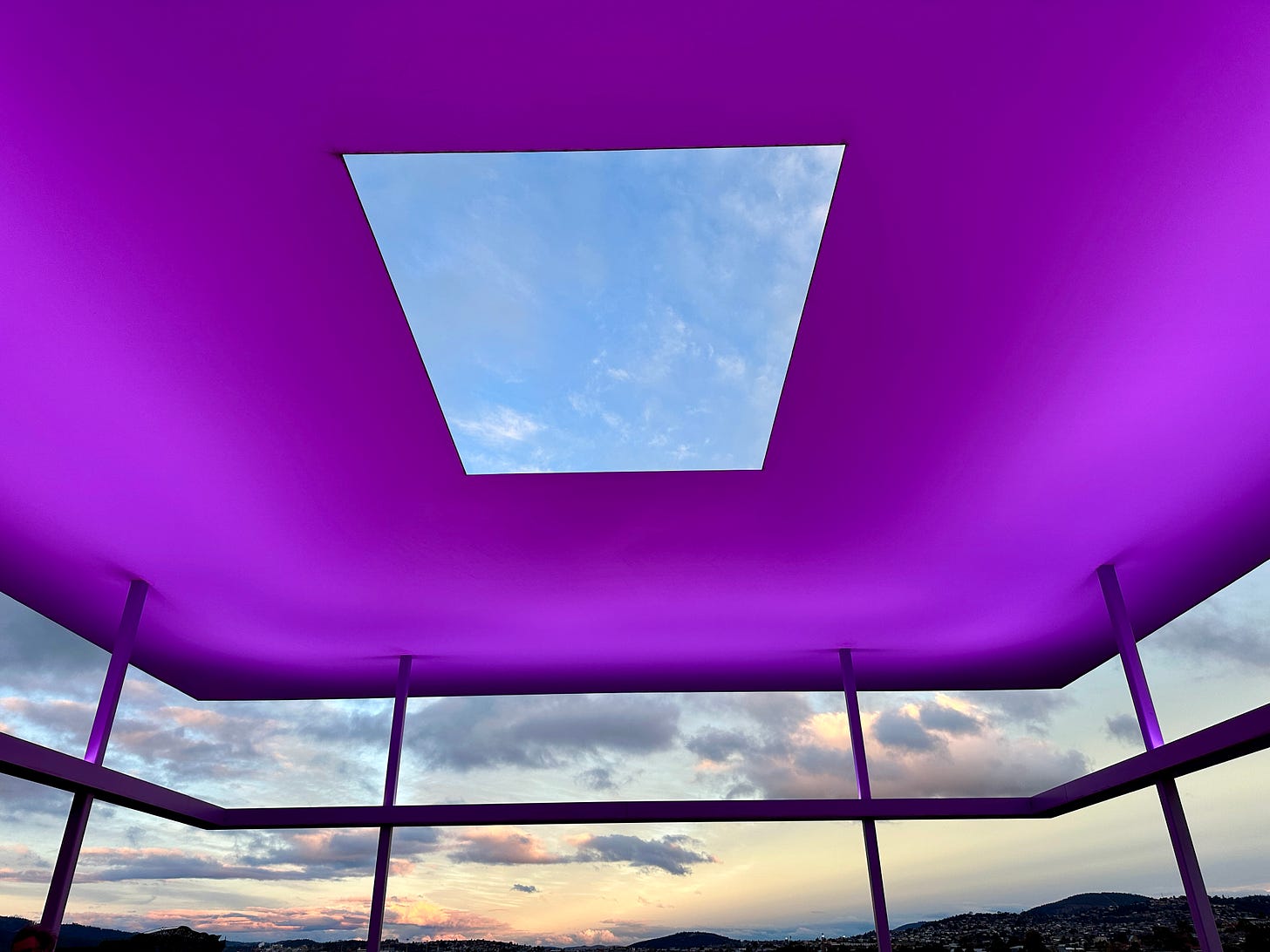Hello friends,
I’m just back from two weeks in Australia. I wrote part of this on a plane from Melbourne to San Francisco, typing out words somewhere over the Pacific Ocean, then later in an airport chair under the haze of time differences and too much mediocre coffee.
Since my husband is Australian, I’ve been there several times, but this was the first visit where it wasn’t blazingly hot. A plane ride to the other side of the world planted me straight into an opposite season. As the Southern Hemisphere heads into winter, sunset was early, a stark contrast to the long days back at home. In Melbourne, dried, yellow leaves coated the sidewalks and people were prepping for the colder season.
I made note of all the Australians in scarves and puffy jackets, how popular it is to go to bed with hot water bottles and electric blankets. Considering that the last time I had been in Australia it was the height of summer and going outside felt like walking into an oven, I was happy with what the Australians consider cooler weather. Although it’s hard to convince someone used to gray, dismal, wet Pacific Northwest winters that a sunny autumn day in this part of the world feels “cold.”
When you’re partnered with someone who hails from another place, you get a kind of familiarity by proxy. You are offered a sense of place that’s different than if you were traveling by your own accord. There are friends and family to plug into, local customs and phrases that you can ease into because they’ve already been a part of your everyday life at home. Personal favorite Aussie term: whipper snipper (a weed whacker).
I know the tug of emotions that results from being rooted in different parts of the world, the feeling of being in-between. It’s rare that all of you is ever in one place. Luc has favorite smells and sounds from his Australian childhood, and I too want to embrace them. The call of the magpie, the smell of eucalyptus trees. They are so foreign to me, so exotic, but I also want to recognize them, have them elicit a sense of place when I’m in contact with them.
That dry and bright, herbaceous smell of eucalyptus on an early morning, as the golden sun peeks through the leaves? That doesn’t feel like home in the way that cedar and Douglas Fir trees do, but it does feel like a very good friend.
We spent a week in Tasmania, including a few days in Hobart. One of those days was dedicated to going to MONA (Museum of Old and New Art). Opened in 2011, MONA is the largest private art museum in the Southern Hemisphere. It’s the creative endeavor of David Walsh, a man who made his money in gambling and is quite famous for getting out of a ridiculously large tax bill.
MONA isn’t so much a museum as it is an architectural compound, complete with several restaurants, outdoor sculptures, high-end overnight accommodations, and even a vineyard and winery. It’s mind-boggling what an enormous amount of wealth can allow you to do.
The museum, which is not without its controversy1, has become a major draw of Hobart, a bit of a “Bilbao effect.” As a visitor, you’re encouraged to get there from the city by ferry, which in true contemporary art style is complete with sheep sculptures as benches and a life-sized sculpture of a cow. Inside, another sheep hangs from the ceiling. The whole experience is highly curated, as if you are partaking in an entire day of performance art.
Last year, MONA was in the news for artist Kirsha Kaechele’s “Ladies Lounge,” an installation where men were barred from entering (except for the butler). As Kaechele defined it, an “essential space for perspective and reset from this strange and disjointed world of male domination.”
Refused entry, a man from Sydney sued on the basis of discrimination, and a tribunal ruled that the installation would have to allow any visitor in. That wasn’t the point of the art, so Kaechele closed the installation, went to the Supreme Court of Tasmania, and eventually had the ruling overturned. The museum now sells a fragrance called “The Verdict” to celebrate the victory. You don’t have a museum like this without pissing some people off.
All to say, a visit to MONA is less of a visit to an art museum and much more of an experience. It’s over the top, a bit cheeky, and very out there.
I liked how old and new art were paired together, ancient cuneiform tablets and Egyptian funereal masks next to bright abstract tableaus, contemporary photography, and the bright lights and pulsing sounds of installations. But my favorite thing at the museum was the 4PM exhibition.
In 2021, local composer and musician Dean Stevenson launched the ultimate creative endeavor. For six months, he would begin each day at the piano with a blank page, charged with writing a new composition. The deadline was tight: he had to have something by 4pm. Come that time, he would take the music he had written and no matter what shape it was in, it would be practiced and performed by a group of musicians. This was all done in front of a live audience.
There was nowhere for his creative process to hide. It was all on display.
As Stevenson writes in his book 4PM 150 First Drafts, “No repeats, no covers, no developments—a fresh piece for every day. For six months. In public. What could go wrong? Just the awkward middle bit.”
Ah yes, the awkward middle bit. We all know it.
Imagine exposing your creative process like this, day in and day out. The deadline is so tight that there is no room to finesse, no space for bringing something polished to the stage. That messy, in-between stage that becomes the road block in so many creative projects? Either get through it by the deadline or share it with the public.
Think for a second how precious we can be with our scribbly notes, our messy sketchbooks, our in-process, half-baked, almost certainly not-quite-there pieces. Imagine you had to let that preciousness go, bring your work into the world no matter what state it was in. That’s exactly what Stevenson does, and no matter the music that’s composed, the process is art in and of itself.
The initial six months eventually turned into ten, and after that, Stevenson and the musicians have continued, currently ongoing until October 2025.
I got to see day 436. As Stevenson described it on the day that I was there, this is a process off “having nothing, finding something.”
In between rehearsing parts of what he had composed that day, he turned to the audience and asked if anyone had any questions. Someone inquired how he makes the music different every day. “It’s impossible to be the same,” he said. “It’s always an evolution of the last idea. That’s just me trying to figure myself out… I continue to show up and look for myself.”
That’s of course what can make the creative process so intimidating.
“Every time I make art, I see myself,” Stevenson said. “If you write a line and go ‘oh fuck,’ that’s because you see yourself.”
The creative process is messy, and so is the human one.
The quartet continued to rehearse, then right before the museum’s closing time, they played the final piece all the way through and the cavernous hall filled with music. I passed by the bookshop on my way out so that I could snag a copy of Stevenson’s book, and I’ve been reading it in small chunks over the past week. It’s a reminder that even in an installation that’s all about process, there’s so much happening behind-the-scenes in an artist’s life that we as the viewer might never get to see. The creative process is not just a process of art, it’s a process of living in the human world. Breakups, world events, love, grief, sadness, joy. Life interwoven into everything that we make.
In the book at the halfway point of his original 150-day endeavor, Stevenson ends with this note:
“Artists plug art into everything they do. It can make the re-telling of their life clearer, or more oblique. It’s not up to them to spell it out for us. It’s up to us to allow them to do it for themselves.”
I like this view, art not as product but as way of seeing, feeling, and understanding the world. Doesn’t matter what the end result is, and as artists, we can work at removing the pressure that our creative work has to be something understandable, something consumable, something for everyone.
No need to soften the edges for the sake of who might engage with it, allow the thing to be what it needs to be.
As violin player Natalya Bing reflected on being one of the 4PM musicians:
“It also reminded me how life can often be lived for the ‘performance moments’ i.e. ‘when X happens, that’s when I’ll start living properly’ … 4PM highlighted that it is all the performance. The toil, the mess, the practice, the adjusting—not just the culmination.”
Before we boarded the 5pm ferry back to Hobart, we caught a glimmer of the changing lights on the James Turrell piece. A violet hue against a darkening sky.
The sun set during the ferry ride back, and as we pulled into the harbor, the lights of Hobart reflected in the water. The dark silhouette of kunanyi/mount Wellington and the surrounding hills rose up behind.
The smell of saltwater, a brisk wind, the meeting of land and sea.
Here at the edge of the world, for a second, I almost recognized it as a place that looked like home. At the very least, the kind of place you’d want to return to.
-Anna
If you’re interested in the 4PM exhibit, Stevenson has recordings of all of the live streams here.
Another favorite piece I saw at MONA was Wind Section Instrumental by Cameron Robbies. Outside the building, a sculpture captures wind-power, send it indoors, and used it to create a drawing. The scrolls of paper with each daily drawing are kept, eventually creating a 50 year archive of wind drawings. You can read more and watch a video of how it works on Robbins’ website.
I caught up on a few things on the very long plane trip including this conversation between
and Craig Mod. Worth a listen for anyone who wants a little publishing geekery and inspiration. I’d also recommend reading Craig’s “rules”’ for his membership program.
If you like getting Creative Fuel, the best way to support it is to get a paid subscription. After all, this is independently produced art and writing. You help keep the coffee flowing and art supplies well stocked.
Other ways to support my work: order something in my shop or buy one of my books.
Fake Picassos for example.















Oh yes the in-between feeling, I know exactly what you're talking about (both me and my partner are transplants from two very different places). And yet, when we go home it feels right but once you've been away for so long, you feel like you don't quite belong anymore either, so this in-betweenness follows you wherever you go. I turn to the sea, because it feels like it connects me to the places I love. Sounds like a marvellous trip! And thanks for the Craig Mod link, been following him and his journey.
I've done enough 100 day projects to know how insane it is to write a new piece of music EVERY DAY. Like no weekend break?! Crazy.